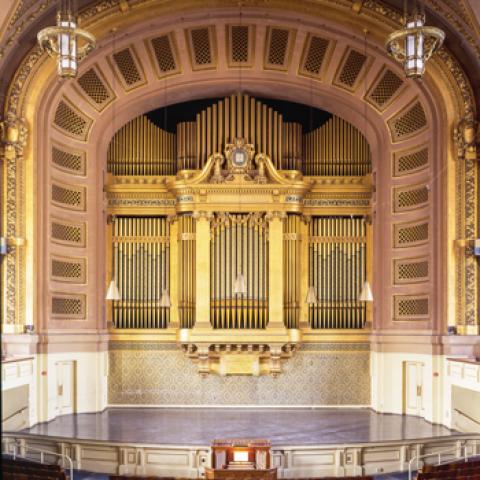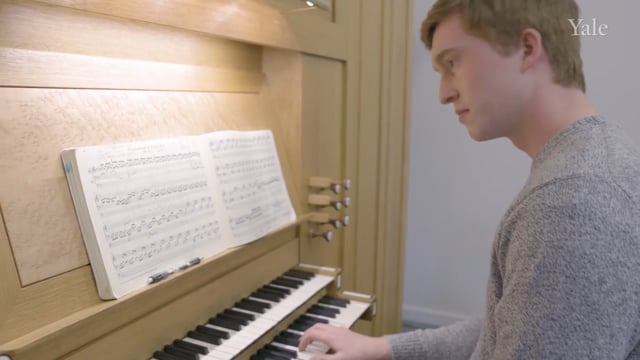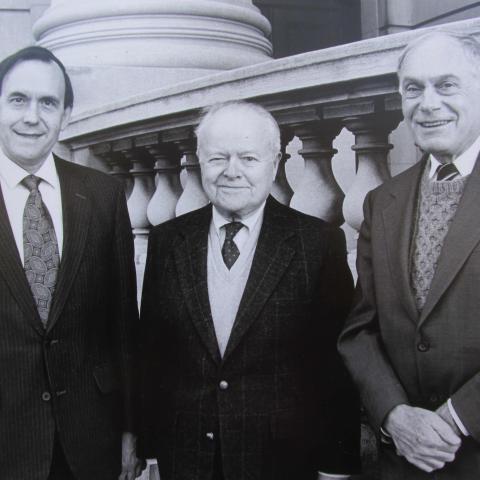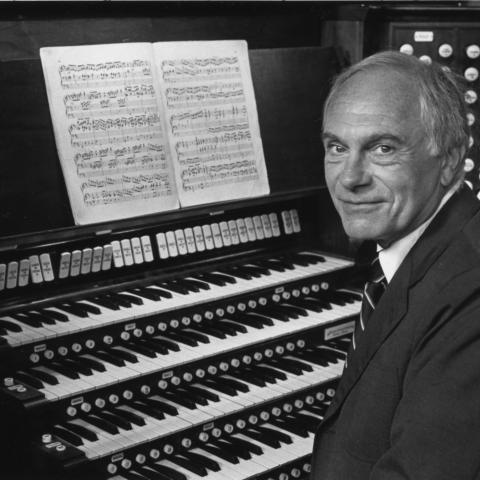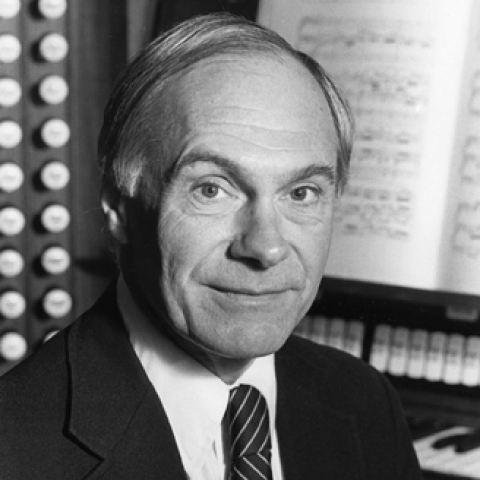Let All the World in Every Corner Sing: The Yale Institute of Sacred Music Celebrates Fifty Years
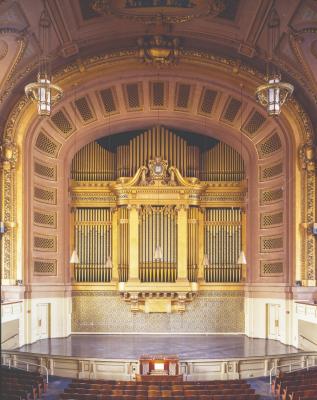
The Yale Institute of Sacred Music (ISM) is an interdisciplinary graduate center for the study and practice of sacred music, worship, and the related arts. Its students pursue degrees in choral conducting, organ, and concert voice with the Yale School of Music, or they engage in ministerial or academic studies in liturgy, religion and literature, music, or visual arts with the Yale Divinity School. The ISM is essentially a sequel to the School of Sacred Music at Union Theological Seminary (New York City), which lost its funding in the early 1970s and closed its doors. Robert Baker, then organist and dean of the School of Sacred Music at Union, relocated three faculty and one administrator from the Union school to Yale in New Haven, Connecticut, after securing funding from the Irwin-Sweeney-Miller foundation of Columbus, Indiana. This family foundation was headed by Clementine Miller Tangeman, whose late husband was a musicologist at Union, and her brother J. Irwin Miller, who was serving as senior trustee of the Yale Corporation. With its strong programs in divinity and music, Yale was deemed the perfect place to reconstitute a school or institute of sacred music. In 1973 inaugural director Robert Baker, together with chaplain and liturgical scholar Jeffery Rowthorn, musicologist Richard French, and administrator Mina Belle Packer, migrated to New Haven. After a year of intense preparation, the Yale ISM welcomed its first class of students: five in music and five in divinity. In 2024 the ISM celebrated the fiftieth anniversary of that momentous occasion.
The School of Sacred Music at Union Theological Seminary
The roots of the ISM begin with Union Theological Seminary. Music was an important component of the curriculum at Union since its founding in 1836. That this ecumenical Protestant seminary held such value for music and the arts can trace some of its inspiration to Anglican and Roman Catholic instantiations of liturgical renewal stemming from the Oxford and Solemnes movements. Church musicians were regularly appointed to the theological faculty at Union to teach music history, hymnody, and related musical subjects to complement the theological education of seminarians.
In 1928 Clarence Dickinson (who had been teaching music to the seminarians at Union since 1912), together with his wife, Helen Snyder Dickinson, met with seminary president Henry Sloane Coffin to discuss establishing a separate entity at Union: a school of sacred music. This school would specifically train church musicians within the context of the seminary. Since the “joining of music and theology, of divinity students and music students, did not seem at variance with the Seminary’s history,” Union began admitting musicians into the seminary, granting them the degree Master of Sacred Music. One sees similarity of vision with that of the Schola Cantorum in Paris, founded by Dickinson’s teacher, Alexander Guilmant.
Clarence and Helen Dickinson were the quintessential interdisciplinary couple. Clarence was an organist, choir director, composer, and teacher whose profound influence earned him the moniker “Dean of American Church Musicians.” His wife Helen, the first woman to graduate with a Ph.D. from Heidelberg University, was an art and liturgical historian who taught alongside her husband at Union. Together they envisioned a curriculum in which the church musician would acquire not only musical skills, but also the theological and pastoral skills needed to successfully navigate the complex ministry of church music. The Dickinsons also understood the benefits of having musicians and clergy interact with each other at the seminary: “In such an atmosphere, the church musician . . . and the minister meet and train together in much the same way as they will work together in actual parish situations.” Interdisciplinary study and collaboration between clergy and musicians were hallmarks of the School of Sacred Music at Union, and it is upon this foundation that the Yale Institute of Sacred Music was built.
Early years at the Yale Institute of Sacred Music
The 1975 Bulletin of the Yale Divinity School includes a succinct description of the ISM: “The curriculum will lay particular stress upon organ playing, choral conducting, historical aspects of the church’s musical development, the liturgical framework of religious worship of all faiths, and practical musical techniques, and will be of a highly participatory nature.” Three early graduates of the program, however—Steven Roberts, Patricia Wright, and Walden Moore—paint a broader, more colorful picture of the nascent ISM and its early years. Steven Roberts was an organ student in the first class that arrived at the ISM in 1974; he later taught organ at Western Connecticut State University and was music director at Saint Peter Church in Danbury before retiring to Bolivia. Patricia Wright was also an inaugural organ student at the ISM, receiving her Master of Musical Arts degree in 1976 and Doctor of Musical Arts degree in 1982. An adjunct organ professor at the University of Toronto, Wright was director of music at Toronto’s Metropolitan United Church, where she played Canada’s largest pipe organ for thirty-five years before retiring in 2022. Walden Moore came to the ISM in 1978. Not long after graduating in 1980, he was appointed organist and choirmaster of Trinity Church on the Green, New Haven. Although Moore retired from Trinity in 2024 after forty years of distinguished service, he and composer/organist Mark Miller continue to teach service playing to organists at the ISM. These three remarkable church musicians share common threads in reminiscing about their time at the ISM in the 1970s: the importance of interdisciplinary study, the emphasis on church music, and the benefits of studying at one of the great research institutions of the world.
Interdisciplinary study in the 1970s primarily involved the study of worship and liturgy. Wright and Roberts both highlight the importance of Jeffery Rowthorn’s liturgy class, Wright going so far as to describe the course as “life changing.” In many ways, it is this study of worship and liturgy—that is, the church at prayer—that unites the musician, seminarian, and scholar. Liturgical studies has become a part of the very DNA of the ISM; it was inherited from the School of Sacred Music at Union, and continues to play a seminal role in the work of the ISM today.
When director Robert Baker brought the ISM to Yale, the School of Music already had an established and prestigious program in organ performance led by university organist Charles Krigbaum. Baker added to the mix an emphasis specifically on training organists for work in the church. Roberts recalls that “Dr. Baker taught me about being a church musician, not just an organist.” Wright remembers Baker teaching conducting from the console. Students were taught the art of leading congregational song and accompanying anthems. Moreover, Baker encouraged students to learn this craft from multiple experts. Moore recalls the director sending him to observe Vernon de Tar on a Sunday morning at Church of the Ascension in New York. Moore was so impressed with this experience that he always welcomed ISM students to observe his program at Trinity.
Yale added a more rigorous academic vision to what had been offered at Union, says Moore, and organists took full advantage of all that Yale had to offer. Roberts took courses on Scarlatti and Couperin with harpsichordist Ralph Kirkpatrick; Wright studied Schenkerian analysis with Allen Forte. Trips to the Beinecke Rare Book and Manuscript Library were commonplace. With a profusion of courses and resources at their fingertips, organists were able to tailor their education to their specific interests while acquiring a solid grounding in church music. “It was up to us organ students to take advantage of the myriad of opportunities Yale afforded us,” says Wright. The opportunities have only increased over time.
The Institute of Sacred Music today
The ISM has grown exponentially over the past fifty years; the original community of three faculty and ten students now numbers well over a hundred individuals. Successive directors have expanded the program. John Cook (1984–1992) created a robust program in religion and the arts at the ISM, a development that undoubtedly would have delighted Helen Dickinson. Under Margot Fassler (1994–2004), the music program expanded from organ and choral conducting to include a major in early vocal music and oratorio (James Taylor, program coordinator). Current director Martin Jean (2005–) has fostered a fellowship program in which international scholars and practitioners join the ISM community for an academic year to further their work while collaborating with the ISM community. Together with the Divinity School, Jean also launched an interdisciplinary program in Music and the Black Church (Braxton Shelley, program director).
An abundance of courses awaits organ students admitted to the ISM. In addition to weekly instruction in organ performance from Martin Jean and/or James O’Donnell, students are invited to lessons and masterclasses with visiting artists. Church music skills, originally taught by Robert Baker during lessons, now include courses in choral conducting (Felicia Barber), liturgical keyboard skills (Walden Moore and Mark Miller), and improvisation (Jeffrey Brillhart). Musicological study has expanded to include both historical musicology (Markus Rathey) and ethnomusicology (Bo kyung Blenda Im). Offerings in liturgical studies comprise courses in historical and contemporary issues taught by an expanding and increasingly diverse faculty. Students wishing to broaden their knowledge in religion and the arts can take courses in religious poetry, architectural history, and other related arts.
Ten concert and liturgical choirs are supported by the ISM, the newest of which is the Yale Consort, a group of professional vocalists who sing evening liturgies (Choral Evensong or Vespers) in local parishes under the direction of James O’Donnell. Organ students accompany these services, acquiring liturgical service playing skills in a unique pedagogical setting from one of the world’s finest and most recognized church musicians.
International study tours, typically every other year, take the entire ISM student body around the globe to study the ways in which sacred arts are manifested in areas of the world not our own. The organ faculty often extend the study tour for their students, to allow them to visit and play the significant organs of the region.
In recent years the ISM has offered a week-long summer Organ Academy, in which advanced undergraduate organ students study with some of the nation’s top organists. Participating students receive daily lessons and attend workshops and recitals, all while interacting with their peers from around the country.
What began as Robert Baker’s humble continuation of the noble interdisciplinary program at Union has blossomed into an extensive program of sacred music, religion, and the arts at one of the world’s leading research institutions. As the ISM celebrates fifty years at Yale, Robert Baker’s stately anthem on the hymn text “Let all the world in every corner sing” provides an apt motto. The interdisciplinary, ecumenical, and expansive vision of the ISM, shaped by faculty, students, performers, and fellows, is indeed one in which all the world in every corner sings. May this glorious vision continue for many years to come.
Organ professors at Yale, 1973 to the present
Charles Krigbaum had already been at Yale for fifteen years when the Institute of Sacred Music arrived in 1973. His legacy at Yale includes acquiring the Rudolf von Beckerath organ for Dwight Chapel (1971), premiering the newly discovered Neumeister Chorales of Bach in Battell Chapel (1985), and recording the organ works of Widor and Messiaen on the Newberry Memorial Organ in Woolsey Hall.
An advocate of the organ reform movement, Krigbaum was well versed in all organ music, his seminars covering composers from Titelouze to Tournemire. He promoted well-roundedness, so that students who came to him with a solid background in the North German Organ School left with an admiration for Widor, and those with knowledge of the Romantic schools left with appreciation for Scheidt.
A student of Clarence Dickinson at the School of Sacred Music at Union Theological Seminary, Robert Baker was the quintessential church musician. In addition to teaching the standard organ literature, he instructed students in the practical skills of the church musician. Baker loved the Newberry Memorial Organ and enjoyed teaching in the Romantic style. He would tell his students to always include a “gum drop” (something sweet that people will enjoy) in every recital. Baker’s arrival at Yale complemented the organ performance program directed by Charles Krigbaum.
Thomas Murray came to Yale in 1981 from the Cathedral of Saint Paul in Boston. An organ student of Clarence Mader at Occidental College, Murray became one of the most renowned and field-changing organists of the second half of the twentieth century. He is best known for his interpretation and transcriptions of the Romantic repertoire. He has concertized around the globe, and his multiple recordings have earned him universal acclaim.
On the Newberry Organ at Yale, Murray taught students the art of registering exhilarating crescendos and dramatic diminuendos. His transcriptions often required manipulation of two enclosed divisions at the same time to gracefully bring out a melody. The Newberry Organ, however, was not merely a symphonic organ for Murray; his teaching of the other Romantic repertoire, whether Rheinberger or Mendelssohn, was most authoritative. Indeed, he brings integrity to every musical style and period.
Martin Jean joined the Yale faculty in 1997. A self-professed generalist, Jean brought with him particular expertise in the north and central European Protestant organ repertories but also sustained a love for the French symphonists. With an earnest interest in historic performance, Jean led the project with Thomas Murray and Margot Fassler that resulted in the meantone organ (Opus 55) of Taylor & Boody in Marquand Chapel. Jean accrued some formal training in theological studies, which made him a natural partner at the ISM.
James O’Donnell came to Yale in 2022 after a forty-year career leading two of the most prominent London choral foundations. As organist and master of the choristers at Westminster Abbey, he presided over such state occasions as the wedding of Katherine Middleton and Prince William, which was broadcast to millions. One of his final acts in London was to lead the music for the funeral liturgy of Queen Elizabeth II, which 4.6 billion people were said to have heard, comprising arguably the largest single broadcast audience in history for an event featuring classical music. An internationally acclaimed concert artist, O’Donnell is a model for many students at the ISM: organist, conductor, liturgical musician.
The pipe organs at Yale
The Newberry Memorial Organ in Woolsey Hall ranks among the finest symphonic organs in the world. The original instrument was built by the Hutchings-Votey Organ Company in 1902. Expanded in 1915 by J. W. Steere & Sons, it was rebuilt and expanded again in 1928 by Skinner Organ Company, all through the generosity of the Newberry family. University organist Harry Jepson, who played in the inaugural recital of the original build (it is reported that there were 3,000 people in attendance despite a drenching rainstorm) as well as both rebuilds, curiously programmed Franck’s Pièce Héroïque in all three recitals.
The final Skinner rebuild is a glorious four-manual Romantic organ with 142 stops, 197 ranks, and 12,641 pipes. While Romantic organs fell out of favor in the decades that followed, many such organs falling victim to replacement or alteration, the Newberry Organ remains in its original condition to this day, a stunning instrument lovingly maintained by the A. Thompson-Allen Company. (The Woolsey Hall organ is featured on the cover of the November 2016 issue of The Diapason.)
The 1951 Holtkamp organ in Battell Chapel is a fine example of the mid-twentieth-century Orgelbewegung. The main three-manual transept organ is complemented by a two-manual apse organ (one organ, two consoles). This organ was designed by university organist Luther Noss together with Walter Holtkamp. Yale’s organ curator, Joe Dzeda, recalls that during Sunday services at Battell Chapel, Noss would often play the prelude and postlude from the transept while assistant university organist H. Frank Bozyan would accompany the choir from the apse console. Built on the principles of low wind pressure, balanced registers, and exposed pipework, this three-manual organ has 71 ranks and 3,740 pipes.
In his History of the Yale School of Music, 1855–1970, Noss, who was later dean of the Yale School of Music, wrote: “With the availability of the Newberry Memorial Organ in Woolsey Hall, an outstanding example of the 19th- and 20th-century ‘romantic design,’ and the classic Holtkamp instrument in Battell Chapel, organ students at Yale would now have the rare and valuable opportunity of studying the organ literature of all periods on the appropriate instrument.” (The Battell Chapel organ is featured on page 1 of the June 1950 issue of The Diapason.)
H. Frank Bozyan was appointed instructor in organ in 1920 to assist Harry Jepson in teaching an organ class that averaged twenty-five students. At the time of his death in 1965, he was university organist and organ instructor emeritus. The three-manual, 54-rank Beckerath in Dwight Hall is named in honor of Bozyan’s forty-five years of dedication to the organ program at Yale. Charles Krigbaum, who followed Bozyan as university organist, had Rudolf von Beckerath design and build this colorful tracker. Notable stops include the Terzian, Trichterregal, and Rankett. Krigbaum adored this organ, presenting a series of five Bach recitals after its installation. Some fourteen years later, on March 21, 1985, Krigbaum, along with nine other organists from Yale and New Haven, performed an all-day Bach marathon to celebrate Bach’s 300th birthday. (The Dwight Chapel organ is featured on page 1 of the December 1971 issue of The Diapason.)
Thomas Murray, Professor Emeritus in the Practice of Organ, likes to speak of Yale’s collection of pipe organs as the “goodly heritage.” The most recent addition to this goodly heritage is the Charles Krigbaum Organ in Marquand Chapel. Martin Jean was the impetus behind this three-manual tracker in meantone temperament built by Taylor & Boody. Modeled on the 1683 Arp Schnitger organ in the St. Jacobi Kirche, Lüdingworth, this instrument is ideal for teaching early organ music. Its seventeenth-century design, however, does not preclude it from playing contemporary organ music; indeed, the ISM commissioned Matthew Suttor to compose a new work, Syntagma, which was premiered by Martin Jean in 2007 as part of its year-long celebration to welcome its newest pipe organ.
For further information
To explore the many opportunities at the Yale Institute of Sacred Music, visit ism.yale.edu. For information about the various degree programs, contact admissions manager Loraine Enlow at loraine.enlow@yale.edu. For information about long- and short-term fellowships, contact assistant director Eben Graves at eben.graves@yale.edu.
—Glen J. Segger, Yale ISM ’95
Lecturer, Yale Divinity School

